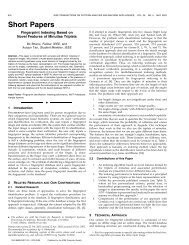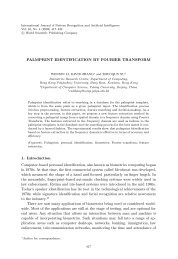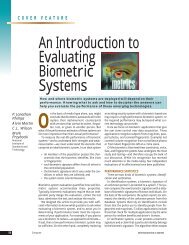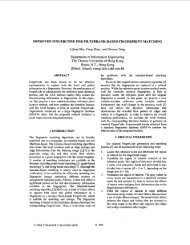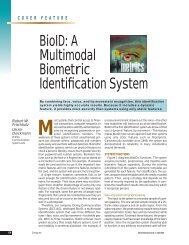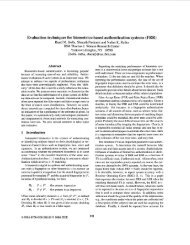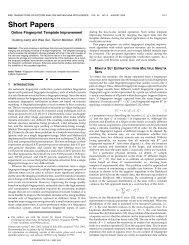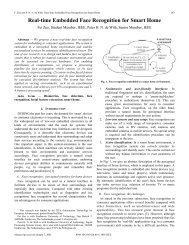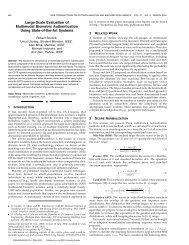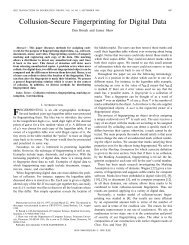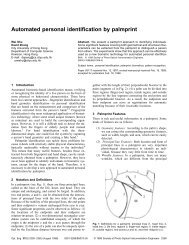A Multichannel Approach to Fingerprint Classification
A Multichannel Approach to Fingerprint Classification
A Multichannel Approach to Fingerprint Classification
Create successful ePaper yourself
Turn your PDF publications into a flip-book with our unique Google optimized e-Paper software.
JAIN ET AL.: A MULTICHANNEL APPROACH TO FINGERPRINT CLASSIFICATION 353Fig. 6. <strong>Fingerprint</strong>s have well defined local frequency and orientation.(a) Ridges in a local region. (b) Fourier spectrum.furrow details in the fingerprint are lost. On the other hand,if they are <strong>to</strong>o small, the filter is not effective in removingnoise. In our algorithm, the values of d x and d y were empiricallydetermined and both were set <strong>to</strong> 4.0.A fingerprint image is decomposed in<strong>to</strong> four componentimages corresponding <strong>to</strong> four different values of q (0 o , 45 o ,90 o , and 135 o ) with respect <strong>to</strong> the x-axis (Fig. 5). A fingerprintimage is convolved with each of the four Gabor filters<strong>to</strong> produce the four component images. Convolution with a0 o -oriented filter accentuates ridges parallel <strong>to</strong> the x-axis,and it smoothes ridges which are not parallel <strong>to</strong> the x-axis.Filters tuned <strong>to</strong> other directions work in a similar way. According<strong>to</strong> our experimental results, the four componentimages capture most of the ridge directionality informationpresent in a fingerprint image and thus form a valid representation.We illustrate this by reconstructing a fingerprintimage by adding <strong>to</strong>gether all the four filtered images. Thereconstructed image is similar <strong>to</strong> the original image but theridges have been enhanced (Fig. 7).Before decomposing the fingerprint image, we normalizethe region of interest in each sec<strong>to</strong>r separately <strong>to</strong> a constantmean and variance. Normalization is done <strong>to</strong> remove theeffects of sensor noise and finger pressure differences. LetI(x, y) denote the gray value at pixel (x, y), M i and V i , theestimated mean and variance of sec<strong>to</strong>r S i , respectively, andN i (x, y), the normalized gray-level value at pixel (x, y). Forall the pixels in sec<strong>to</strong>r S i , the normalized image is defined as:N x,yi1 6=%& K' K2V73I1x,y6-M80iM0+V, if I x,y > Mii(13)22V073I1 x,y6-Mi8M -, otherwise,0Vi21 6where M 0 and V 0 are the desired mean and variance values,respectively. Normalization is a pixel-wise operation whichdoes not change the clarity of the ridge and furrow structures.If normalization is done on the entire image, then itcannot compensate for the intensity variations in the differentparts of the finger due <strong>to</strong> finger pressure differences.Normalization of each sec<strong>to</strong>r separately alleviates this problem.For our experiments, we set both M 0 and V 0 <strong>to</strong> a valueof 100. Normalized, filtered, and reconstructed images for thefingerprint shown in Fig. 4 are shown in Fig. 7.2.3 Feature Vec<strong>to</strong>rIn each component image, a local neighborhood withridges and furrows that are parallel <strong>to</strong> the correspondingFig. 7. Normalized, filtered, and reconstructed fingerprint images. (a)Normalized image. (b) Component image 0°. (c) Component image45°. (d) Component image 90°. (e) Component image 135°. (f) Reconstructedimage.filter direction exhibits a higher variation, whereas a localneighborhood with ridges and furrows that are not parallel<strong>to</strong> the corresponding filter tends <strong>to</strong> be diminished bythe filter which results in a lower variation. The spatialdistribution of the variations in local neighborhoods of thecomponent images thus constitutes a characterization ofthe global ridge structures and is well captured by thestandard deviation of grayscale values. In our algorithm,the standard deviation within the sec<strong>to</strong>rs defines the featurevec<strong>to</strong>r.Let C iq (x, y) be the component image corresponding <strong>to</strong> qfor sec<strong>to</strong>r S i . For "i, i = 0, 1, ¡, 47 and q ³ [0 o , 45 o , 90 o , 135 o ],a feature is the standard deviation F iq , defined as:3 1 6 8 2 , (14)Fi = Ê Ci x,y - Miq q qK iwhere K i is the number of pixels in S i and M iq is the mean ofthe pixel values in C iq (x, y). The 192-dimensional featurevec<strong>to</strong>rs, also called FingerCodes (similar <strong>to</strong> the IrisCode



